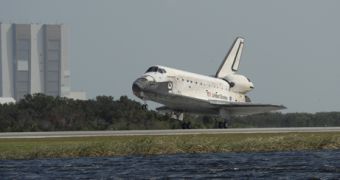The Discovery shuttle and its crew returned to Earth on Wednesday after a challenging 15-day build and repair mission on the International Space Station, completing one of the most difficult missions in history attended by NASA. It was the first shuttle to try a coast-to-coast re-entry after the Columbia disintegration almost five years ago.
The primary mission of the Discovery's crew was to deliver and pressurize the new compartment, named Harmony and to move a girder from one side of the space station to the other. After that, they attended to maintenance work around the International Space Station.
The first maintenance mission was to inspect and repair a rotary joint, which allowed the moving of a solar panel and face it toward the Sun, which was experiencing unusual vibrations and power peaks. Upon further inspection they have found metal shaving, evidence of severe friction between the metal joints. Since they did not have the necessary tools to repair it, it was locked into a stationary position to prevent further damage.
The second blow came when the crew tried to install two supplementary solar panels. The first one unfolded without problems, but the second one snagged into some guide wires, ripping it into two places. Since the solar panels power the International Space Station, it was critical for the future missions. In a few days flight engineers designed a plan to repair the damaged solar panel and on Sunday astronaut Scott Parazynski effectuated the most dangerous spacewalks in the entire history.
During the mission in space, Discovery made 238 revolutions around the Earth and traveled more than 10 million kilometers.
Careful inspections revealed that the spaceship's thermal shield is intact and ready to hold the heat of the atmospheric re-entry, which can reach temperatures as high as 1.630 degrees Celsius.
Due to the success of the repair mission of the solar panel, NASA can now look forward to the launch of a Japanese laboratory in February next year. Now they have to determine if there is enough power to support the massive addition of the module.

 14 DAY TRIAL //
14 DAY TRIAL //